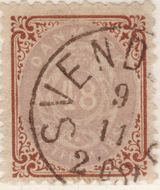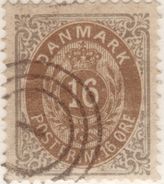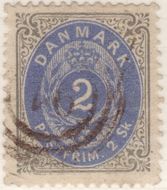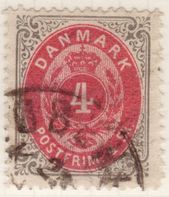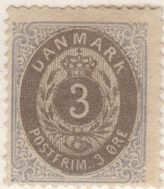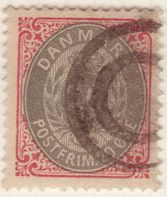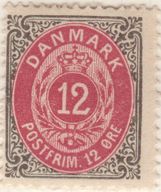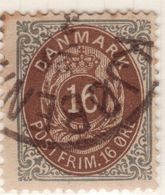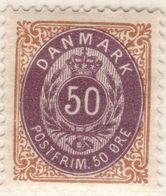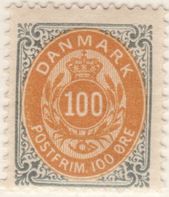
Latest update: 2013-
All prices in €.
C = price less than 0,25 €
DENMARK
Informations of
artists and other details can be found on Post & Tele museum
All rights belong to frimindeks.dk © 2006-
Bicoulered 1870-
Types of frames -
The bicoloured stamps dominated from the first issue 48 sk in 1870 until the last issues came in 1905. This is the longest period in Danish philately, where one type of stamps have dominated.
It is not a surprise that nearly all values exists in a large number of varieties due to different perforation, watermark or colour. Most of the values can be divided into the specific print based on the mentioned differences.
The values did not change much during the period from 1870 to 1905 -
The stamps were printed with the frames and the oval with the value separately. The frames were used on different values and had to be replaced more frequently than the plates with the value. There are five different types of frames. And all five types of frames exist in normal position and inverted position. This means that there are 10 different types of frames. No value exist with all types of frames. The different types of frames are called frame type 1, frame type 2 etc.
Below you find illustrations of the different types of frames. Normally it is not difficult to see the difference between the types. The two types 2 and 3 are the most difficult to distinguish.
Inverted frame.
For the identification of the position of the frame (normal or inverted), the easiest
is to look at the upper left corner of the stamp. Or you can use the opposite corner
-
The fives types of frames are recognised by the following characteristics (described as normal frames!).
Frame type 1. The frame has thicker lines than the other frames. The five feathers in the corners are close to 3 mm broad, while they are close to 2½ mm in the other types of frames.
Frame type 2. The frame has narrow feathers in the middle, which are thin and sharp. In the lower right corner the feather in the middle is very thin and a little crooked. Frame 2 was not used on the sheets for stamps with øre. A few frames were used later with sheets mainly of frame 3 stamps. Øre stamps with frame 2 are rare. Øre stamps with frame 2 are not known with inverted frame.
Frame type 3. The frame looks a lot like rammetype 2 (frame 2), but the feathers are a little shaper and the lower right corner does not differ significantly from the others.
Frame type 4. The frame is normally easy recognised by the middle feather in the lower left corner. The tip is cut off.
Frame type 5. This frame is easily recognised by the middle feathers, which are all with round tips.
|
|
Normal frame |
Upper left corner in normal frame |
Inverted frame |
Upper left corner in inverted frame |
|
Type 1 1870- |
|
|
|
|
|
Type 2 1870- |
|
|
|
|
|
Type 3 1873- |
|
|
|
|
|
Type 4 1878- |
|
|
|
|
|
Type 5 1890- |
|
|
|
|


































